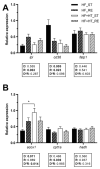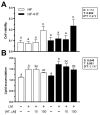Impact of Hydroxytyrosol-Rich Extract Supplementation in a High-Fat Diet on Gilthead Sea Bream (Sparus aurata) Lipid Metabolism
- PMID: 38671851
- PMCID: PMC11047642
- DOI: 10.3390/antiox13040403
Impact of Hydroxytyrosol-Rich Extract Supplementation in a High-Fat Diet on Gilthead Sea Bream (Sparus aurata) Lipid Metabolism
Abstract
High-fat diets (HFDs) enhance fish growth by optimizing nutrient utilization (i.e., protein-sparing effect); however, their potential negative effects have also encouraged the search for feed additives. This work has investigated the effects of an extract rich in a polyphenolic antioxidant, hydroxytyrosol (HT), supplemented (0.52 g HT/kg feed) in a HFD (24% lipid) in gilthead sea bream (Sparus aurata). Fish received the diet at two ration levels, standard (3% of total fish weight) or restricted (40% reduction) for 8 weeks. Animals fed the supplemented diet at a standard ration had the lowest levels of plasma free fatty acids (4.28 ± 0.23 mg/dL versus 6.42 ± 0.47 in the non-supplemented group) and downregulated hepatic mRNA levels of lipid metabolism markers (ppara, pparb, lpl, fatp1, fabp1, acox1, lipe and lipa), supporting potential fat-lowering properties of this compound in the liver. Moreover, the same animals showed increased muscle lipid content and peroxidation (1.58- and 1.22-fold, respectively, compared to the fish without HT), suggesting the modulation of body adiposity distribution and an enhanced lipid oxidation rate in that tissue. Our findings emphasize the importance of considering this phytocompound as an optimal additive in HFDs for gilthead sea bream to improve overall fish health and condition.
Keywords: Sparus aurata; aquafeeds; feed additive; high-fat diet; lipid metabolism; olive polyphenols.
Conflict of interest statement
The authors declare no conflicts of interest.
Figures






Similar articles
-
Hydroxytyrosol-rich extract from olive juice as an additive in gilthead sea bream juveniles fed a high-fat diet: Regulation of somatic growth.Front Physiol. 2022 Oct 6;13:966175. doi: 10.3389/fphys.2022.966175. eCollection 2022. Front Physiol. 2022. PMID: 36277183 Free PMC article.
-
Effect of melatonin and folic acid supplementation on the growth performance, antioxidant status, and liver histology of the farmed gilthead sea bream (Sparus aurata L.) under standard rearing conditions.Fish Physiol Biochem. 2020 Dec;46(6):2265-2280. doi: 10.1007/s10695-020-00879-5. Epub 2020 Sep 25. Fish Physiol Biochem. 2020. PMID: 32978696
-
Olive oil bioactive compounds increase body weight, and improve gut health and integrity in gilthead sea bream (Sparus aurata).Br J Nutr. 2017 Feb;117(3):351-363. doi: 10.1017/S0007114517000228. Epub 2017 Mar 1. Br J Nutr. 2017. PMID: 28245885
-
The potential of a combination of pungent spices as a novel supplement in gilthead seabream (Sparus aurata) diets to aid in the strategic use of fish oil in aquafeeds: a holistic perspective.Front Immunol. 2023 Sep 25;14:1222173. doi: 10.3389/fimmu.2023.1222173. eCollection 2023. Front Immunol. 2023. PMID: 37818366 Free PMC article.
-
Effects of diet supplementation with white tea and methionine on lipid metabolism of gilthead sea bream juveniles (Sparus aurata).Fish Physiol Biochem. 2013 Jun;39(3):661-70. doi: 10.1007/s10695-012-9728-8. Epub 2012 Oct 2. Fish Physiol Biochem. 2013. PMID: 23053611
Cited by
-
Modulation of Digestive Enzyme Activities and Intestinal γ-Proteobacteria in Gilthead Sea Bream Fed High-Fat Diets Supplemented with HIDROX® Olive Oil Extract.Animals (Basel). 2025 Jul 16;15(14):2102. doi: 10.3390/ani15142102. Animals (Basel). 2025. PMID: 40723564 Free PMC article.
References
-
- Turchini G.M., Francis D.S., Du Z.Y., Olsen R.E., Ringø E., Tocher D.R. Fish Nutrition. Volume 3. Academic Press; Cambridge, MA, USA: 2022. The lipids; pp. 303–467.
-
- Sabzi E., Mohammadiazarm H., Salati A.P. Effect of dietary L-carnitine and lipid levels on growth performance, blood biochemical parameters and antioxidant status in juvenile common carp (Cyprinus carpio) Aquaculture. 2017;480:89–93. doi: 10.1016/j.aquaculture.2017.08.013. - DOI
-
- Tang T., Hu Y., Peng M., Chu W., Hu Y., Zhong L. Effects of high-fat diet on growth performance, lipid accumulation and lipid metabolism-related MicroRNA/gene expression in the liver of grass carp (Ctenopharyngodon idella) Comp. Biochem. Physiol. Part B Biochem. Mol. Biol. 2019;234:34–40. doi: 10.1016/j.cbpb.2019.04.006. - DOI - PubMed
Grants and funding
LinkOut - more resources
Full Text Sources

